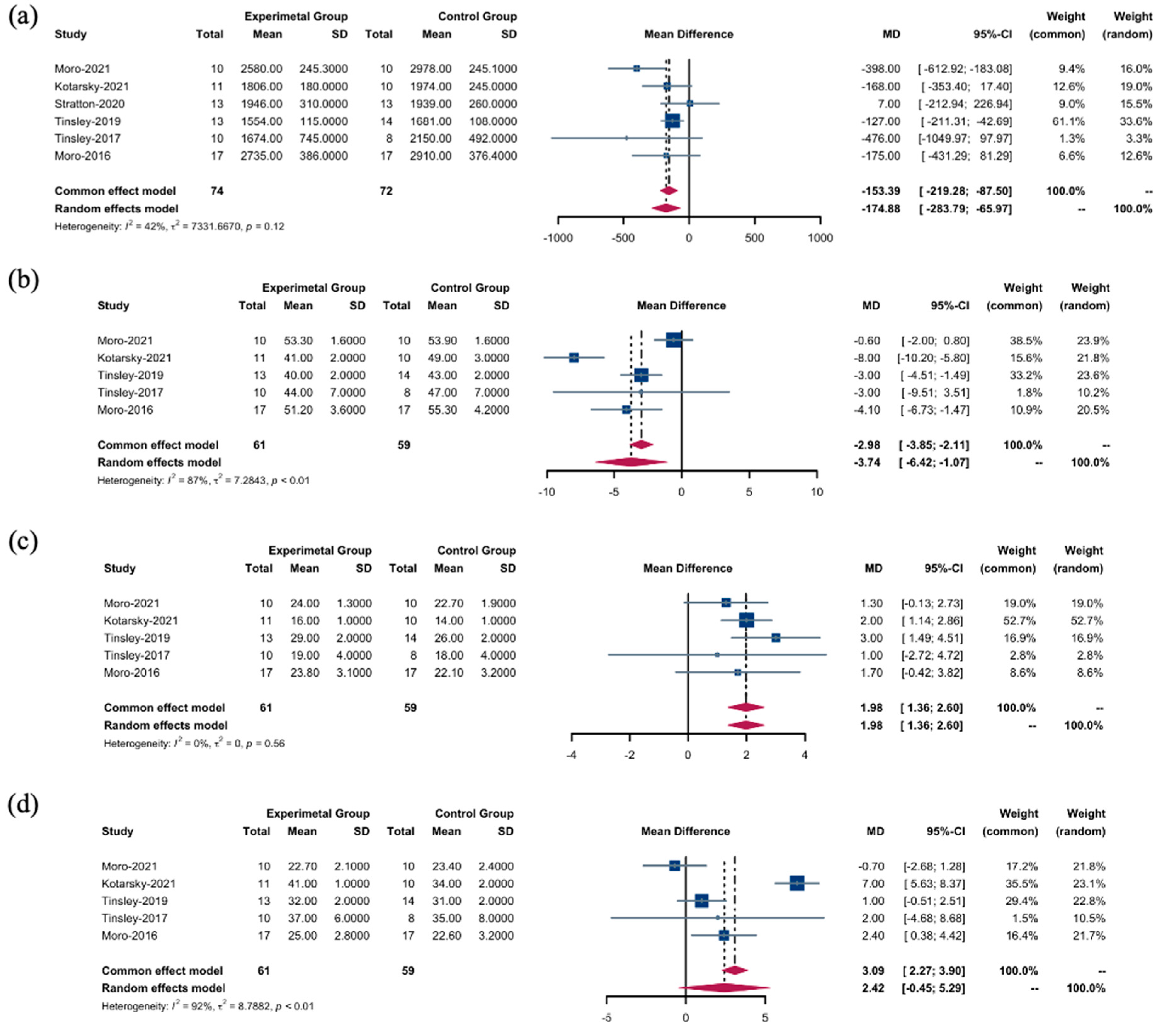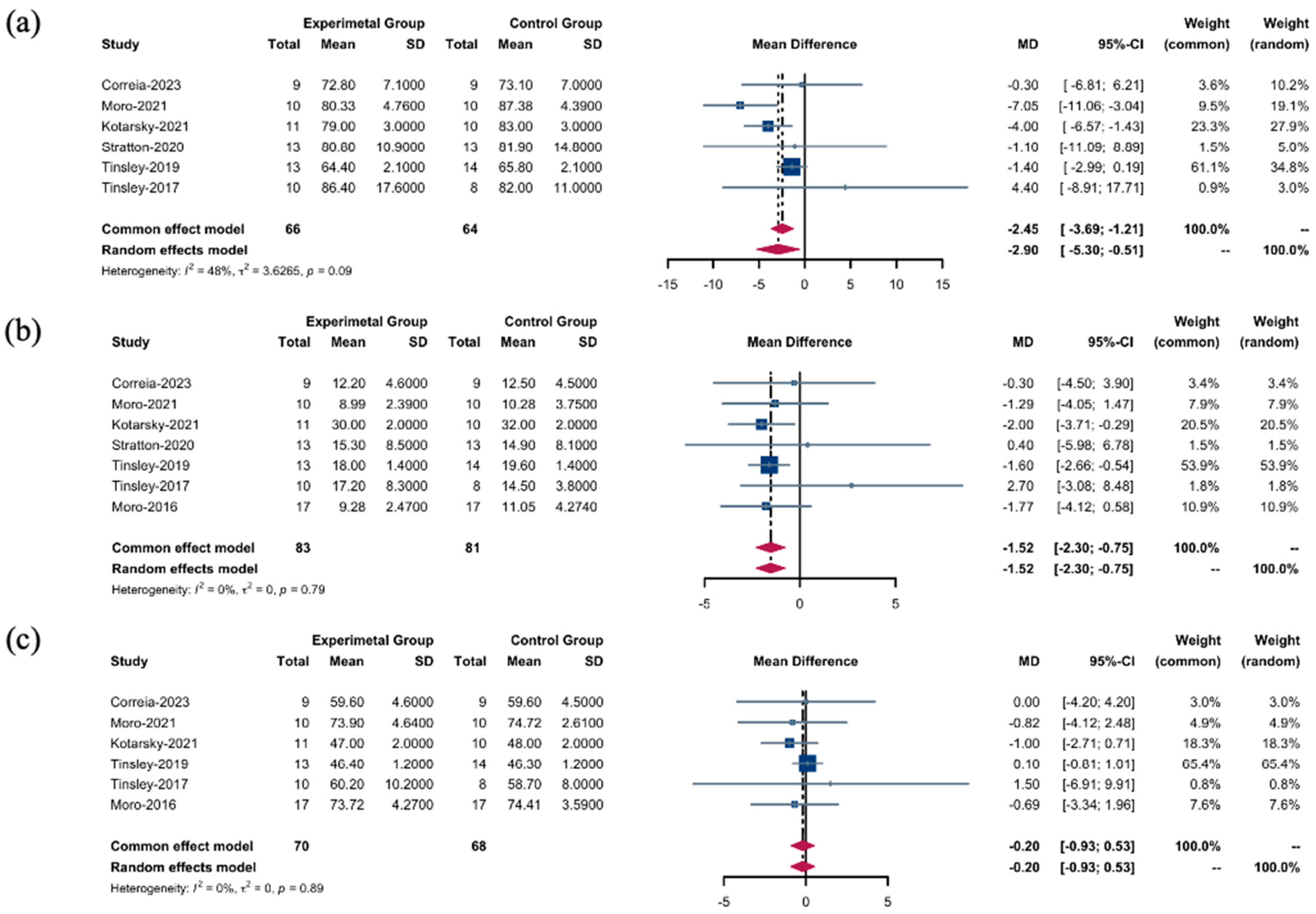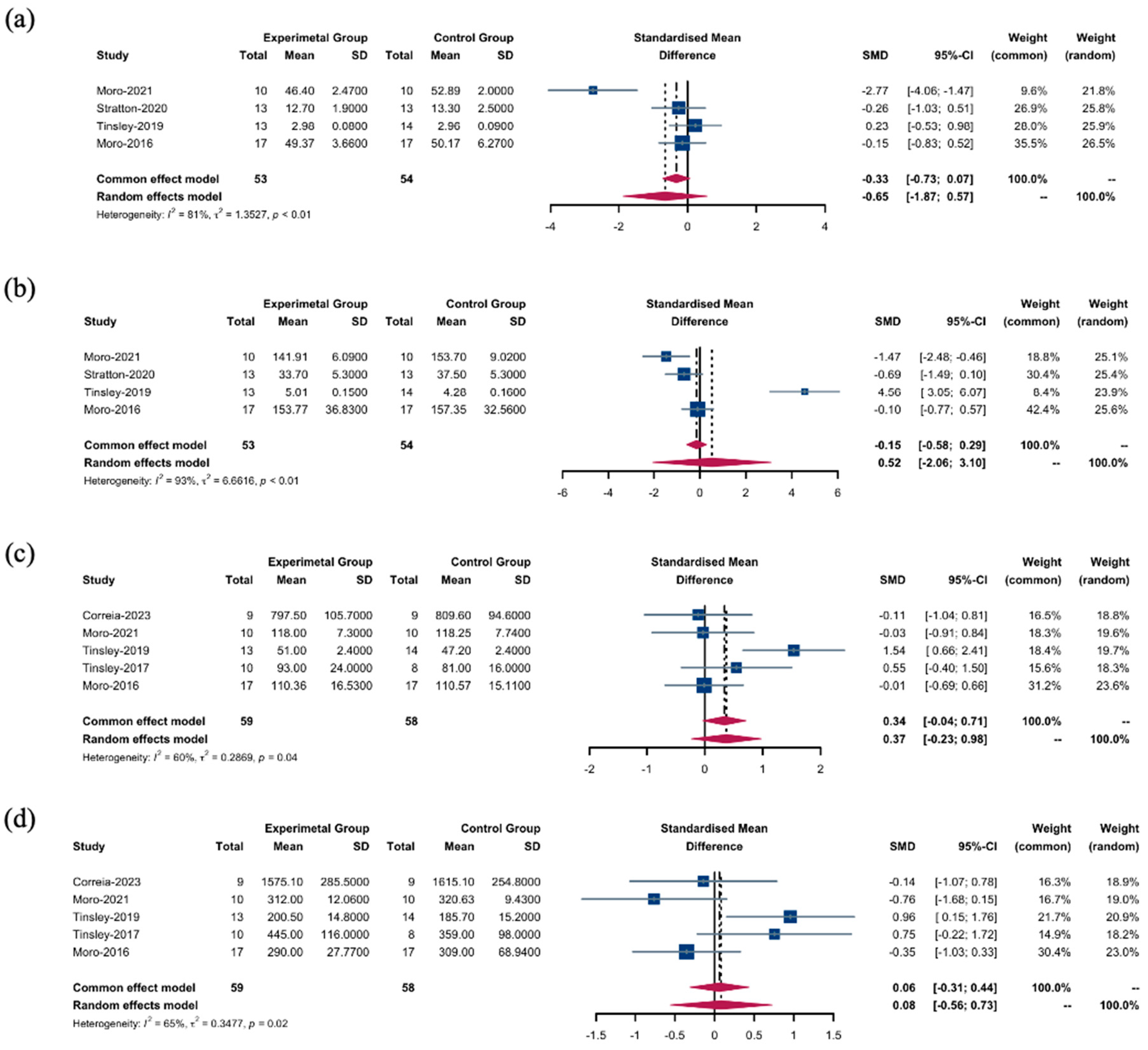Synergistic Effects of Time-Restricted Feeding and Resistance Training on Body Composition and Metabolic Health: A Systematic Review and Meta-Analysis
Abstract
1. Introduction
2. Materials and Methods
2.1. Protocol and Registration
2.2. Search Strategies
2.3. Eligibility Criteria
2.4. Data Extraction
2.5. Data Synthesis
2.6. Data Analysis
2.7. Risk of Bias
2.8. Publication Bias
3. Results
3.1. Study Inclusion
3.2. Study Characteristics
3.3. Effects of Interventions
3.3.1. Energy Intake
3.3.2. Body Composition
3.3.3. Muscle Changes
3.3.4. Biomarkers
3.4. Risk of Bias
3.5. Sensitivity Analyses and Publication Bias
4. Discussion
5. Conclusions
Supplementary Materials
Author Contributions
Funding
Conflicts of Interest
References
- Izquierdo, M.; Merchant, R.A.; Morley, J.E.; Anker, S.D.; Aprahamian, I.; Arai, H.; Aubertin-Leheudre, M.; Bernabei, R.; Cadore, E.L.; Cesari, M.; et al. International Exercise Recommendations in Older Adults (ICFSR): Expert Consensus Guidelines. J. Nutr. Health Aging 2021, 25, 824–853. [Google Scholar] [CrossRef]
- McTigue, K.M.; Harris, R.; Hemphill, B.; Lux, L.; Sutton, S.; Bunton, A.J.; Lohr, K.N. Screening and Interventions for Obesity in Adults: Summary of the Evidence for the U.S. Preventive Services Task Force. Ann. Intern. Med. 2003, 139, 933–949. [Google Scholar] [CrossRef] [PubMed]
- Chaix, A.; Rynders, C.A. Time Restricted Feeding plus Exercise: Could Two Be Better than One for Metabolic Health? J. Physiol. 2022, 600, 699–700. [Google Scholar] [CrossRef]
- Antoni, R.; Robertson, T.M.; Robertson, M.D.; Johnston, J.D. A Pilot Feasibility Study Exploring the Effects of a Moderate Time-Restricted Feeding Intervention on Energy Intake, Adiposity and Metabolic Physiology in Free-Living Human Subjects. J. Nutr. Sci. 2018, 7, e22. [Google Scholar] [CrossRef]
- Hoddy, K.K.; Marlatt, K.L.; Çetinkaya, H.; Ravussin, E. Intermittent Fasting and Metabolic Health: From Religious Fast to Time-Restricted Feeding. Obesity 2020, 28, S29–S37. [Google Scholar] [CrossRef] [PubMed]
- Ezzati, A.; Rosenkranz, S.K.; Phelan, J.; Logan, C. The Effects of Isocaloric Intermittent Fasting vs Daily Caloric Restriction on Weight Loss and Metabolic Risk Factors for Noncommunicable Chronic Diseases: A Systematic Review of Randomized Controlled or Comparative Trials. J. Acad. Nutr. Diet. 2023, 123, 318–329.e1. [Google Scholar] [CrossRef]
- Réda, A.; Wassil, M.; Mériem, M.; Alexia, P.; Abdelmalik, H.; Sabine, B.; Nassir, M. Food Timing, Circadian Rhythm and Chrononutrition: A Systematic Review of Time-Restricted Eating’s Effects on Human Health. Nutrients 2020, 12, 3770. [Google Scholar] [CrossRef]
- Bao, R.; Sun, Y.; Jiang, Y.; Ye, L.; Hong, J.; Wang, W. Effects of Time-Restricted Feeding on Energy Balance: A Cross-Over Trial in Healthy Subjects. Front. Endocrinol. 2022, 13, 870054. [Google Scholar] [CrossRef]
- Barnosky, A.R.; Hoddy, K.K.; Unterman, T.G.; Varady, K.A. Intermittent Fasting vs Daily Calorie Restriction for Type 2 Diabetes Prevention: A Review of Human Findings. Transl. Res. 2014, 164, 302–311. [Google Scholar] [CrossRef] [PubMed]
- Sutton, E.F.; Beyl, R.; Early, K.S.; Cefalu, W.T.; Ravussin, E.; Peterson, C.M. Early Time-Restricted Feeding Improves Insulin Sensitivity, Blood Pressure, and Oxidative Stress Even without Weight Loss in Men with Prediabetes. Cell Metab. 2018, 27, 1212–1221.e3. [Google Scholar] [CrossRef]
- Lundell, L.S.; Parr, E.B.; Devlin, B.L.; Ingerslev, L.R.; Altıntaş, A.; Sato, S.; Sassone-Corsi, P.; Barrès, R.; Zierath, J.R.; Hawley, J.A. Time-Restricted Feeding Alters Lipid and Amino Acid Metabolite Rhythmicity without Perturbing Clock Gene Expression. Nat. Commun. 2020, 11, 4643. [Google Scholar] [CrossRef]
- Roig, M.; O’Brien, K.; Kirk, G.; Murray, R.; McKinnon, P.; Shadgan, B.; Reid, W.D. The Effects of Eccentric versus Concentric Resistance Training on Muscle Strength and Mass in Healthy Adults: A Systematic Review with Meta-Analysis. Br. J. Sports Med. 2009, 43, 556–568. [Google Scholar] [CrossRef]
- Chow, L.S.; Manoogian, E.N.C.; Alvear, A.; Fleischer, J.G.; Thor, H.; Dietsche, K.; Wang, Q.; Hodges, J.S.; Esch, N.; Malaeb, S.; et al. Time-Restricted Eating Effects on Body Composition and Metabolic Measures in Humans Who Are Overweight: A Feasibility Study. Obesity 2020, 28, 860–869. [Google Scholar] [CrossRef]
- Parr, E.B.; Kouw, I.W.K.; Wheeler, M.J.; Radford, B.E.; Hall, R.C.; Senden, J.M.; Goessens, J.P.B.; van Loon, L.J.C.; Hawley, J.A. Eight-Hour Time-Restricted Eating Does Not Lower Daily Myofibrillar Protein Synthesis Rates: A Randomized Control Trial. Obesity 2023, 31 (Suppl. S1), 116–126. [Google Scholar] [CrossRef]
- Williamson, E.; Moore, D.R. A Muscle-Centric Perspective on Intermittent Fasting: A Suboptimal Dietary Strategy for Supporting Muscle Protein Remodeling and Muscle Mass? Front. Nutr. 2021, 8, 319. [Google Scholar] [CrossRef] [PubMed]
- Sparti, A.; Delany, J.P.; De La Bretonne, J.A.; Sander, G.E.; Bray, G.A. Relationship between Resting Metabolic Rate and the Composition of the Fat-Free Mass. Metabolism 1997, 46, 1225–1230. [Google Scholar] [CrossRef] [PubMed]
- Hunter, G.R.; Byrne, N.M.; Sirikul, B.; Fernández, J.R.; Zuckerman, P.A.; Darnell, B.E.; Gower, B.A. Resistance Training Conserves Fat-Free Mass and Resting Energy Expenditure Following Weight Loss. Obesity 2008, 16, 1045–1051. [Google Scholar] [CrossRef]
- Tinsley, G.M.; Moore, M.L.; Graybeal, A.J.; Paoli, A.; Kim, Y.; Gonzales, J.U.; Harry, J.R.; Vandusseldorp, T.A.; Kennedy, D.N.; Cruz, M.R. Time-Restricted Feeding plus Resistance Training in Active Females: A Randomized Trial. Am. J. Clin. Nutr. 2019, 110, 628–640. [Google Scholar] [CrossRef] [PubMed]
- Ferri Antonio, G.C.; Ramos da Silva, A.S.; De Freitas, E.C.; Pauli, J.R. Time-Restricted Feeding and Weight Loss in Obesity: A Mini Review on the Impacts on Skeletal Muscle Mass. Obesities 2023, 3, 218–224. [Google Scholar] [CrossRef]
- Dai, Z.; Wan, K.; Miyashita, M.; Ho, R.S.-t.; Zheng, C.; Poon, E.T.-c.; Wong, S.H.-s. The Effect of Time-Restricted Eating Combined with Exercise on Body Composition and Metabolic Health: A Systematic Review and Meta-Analysis. Adv. Nutr. 2024, 15, 100262. [Google Scholar] [CrossRef]
- Keenan, S.; Cooke, M.B.; Belski, R. The Effects of Intermittent Fasting Combined with Resistance Training on Lean Body Mass: A Systematic Review of Human Studies. Nutrients 2020, 12, 2349. [Google Scholar] [CrossRef] [PubMed]
- Moro, T.; Tinsley, G.; Bianco, A.; Marcolin, G.; Pacelli, Q.F.; Battaglia, G.; Palma, A.; Gentil, P.; Neri, M.; Paoli, A. Effects of Eight Weeks of Time-Restricted Feeding (16/8) on Basal Metabolism, Maximal Strength, Body Composition, Inflammation, and Cardiovascular Risk Factors in Resistance-Trained Males. J. Transl. Med. 2016, 14, 290. [Google Scholar] [CrossRef] [PubMed]
- Sterne, J.A.C.; Savović, J.; Page, M.J.; Elbers, R.G.; Blencowe, N.S.; Boutron, I.; Cates, C.J.; Cheng, H.Y.; Corbett, M.S.; Eldridge, S.M.; et al. RoB 2: A Revised Tool for Assessing Risk of Bias in Randomised Trials. BMJ 2019, 366, l4898. [Google Scholar] [CrossRef]
- Correia, J.M.; Santos, P.D.G.; Pezarat-correia, P.; Minderico, S.; Infante, J.; Mendonca, G.V. Effect of Time-Restricted Eating and Resistance Training on High-Speed Strength and Body Composition. Nutrients 2023, 15, 285. [Google Scholar] [CrossRef] [PubMed]
- Moro, T.; Tinsley, G.; Pacelli, F.Q.; Marcolin, G.; Bianco, A.; Paoli, A. Twelve Months of Time-Restricted Eating and Resistance Training Improves Inflammatory Markers and Cardiometabolic Risk Factors. Med. Sci. Sports Exerc. 2021, 53, 2577–2585. [Google Scholar] [CrossRef]
- Kotarsky, C.J.; Johnson, N.R.; Mahoney, S.J.; Mitchell, S.L.; Schimek, R.L.; Stastny, S.N.; Hackney, K.J. Time-Restricted Eating and Concurrent Exercise Training Reduces Fat Mass and Increases Lean Mass in Overweight and Obese Adults. Physiol. Rep. 2021, 9, e14868. [Google Scholar] [CrossRef] [PubMed]
- Stratton, M.T.; Tinsley, G.M.; Alesi, M.G.; Hester, G.M.; Olmos, A.A.; Serafini, P.R.; Modjeski, A.S.; Mangine, G.T.; King, K.; Savage, S.N.; et al. Four Weeks of Time-Restricted Feeding Combined with Resistance Training Does Not Differentially Influence Measures of Body Composition, Muscle Performance, Resting Energy Expenditure, and Blood Biomarkers. Nutrients 2020, 12, 1126. [Google Scholar] [CrossRef]
- Tinsley, G.M.; Forsse, J.S.; Butler, N.K.; Paoli, A.; Bane, A.A.; La Bounty, P.M.; Morgan, G.B.; Grandjean, P.W. Time-Restricted Feeding in Young Men Performing Resistance Training: A Randomized Controlled Trial. Eur. J. Sport. Sci. 2017, 17, 200–207. [Google Scholar] [CrossRef]
- Martins, C.; Gower, B.A.; Hunter, G.R. Association between Fat-Free Mass Loss after Diet and Exercise Interventions and Weight Regain in Women with Overweight. Med. Sci. Sports Exerc. 2022, 54, 2031–2036. [Google Scholar] [CrossRef]
- Kazeminasab, F.; Baharlooie, M.; Karimi, B.; Mokhtari, K.; Rosenkranz, S.K.; Santos, H.O. Effects of Intermittent Fasting Combined with Physical Exercise on Cardiometabolic Outcomes: Systematic Review and Meta-Analysis of Clinical Studies. Nutr. Rev. 2023, nuad155. [Google Scholar] [CrossRef]
- Ashtary-Larky, D.; Bagheri, R.; Tinsley, G.M.; Asbaghi, O.; Paoli, A.; Moro, T. Effects of Intermittent Fasting Combined with Resistance Training on Body Composition: A Systematic Review and Meta-Analysis. Physiol. Behav. 2021, 237, 113453. [Google Scholar] [CrossRef] [PubMed]
- Oconnor, S.G.; Boyd, P.; Bailey, C.P.; Shams-White, M.M.; Agurs-Collins, T.; Hall, K.; Reedy, J.; Sauter, E.R.; Czajkowski, S.M. Perspective: Time-Restricted Eating Compared with Caloric Restriction: Potential Facilitators and Barriers of Long-Term Weight Loss Maintenance. Adv. Nutr. 2021, 12, 325–333. [Google Scholar] [CrossRef]
- Lin, S.; Cienfuegos, S.; Ezpeleta, M.; Gabel, K.; Pavlou, V.; Mulas, A.; Chakos, K.; McStay, M.; Wu, J.; Tussing-Humphreys, L.; et al. Time-Restricted Eating Without Calorie Counting for Weight Loss in a Racially Diverse Population. Ann. Intern. Med. 2023, 176, 885–895. [Google Scholar] [CrossRef]
- Chew, H.S.J.; Ang, W.H.D.; Tan, Z.Y.A.; Ang, W.W.; Chan, K.S.; Lau, Y. Umbrella Review of Time-Restricted Eating on Weight Loss, Fasting Blood Glucose, and Lipid Profile. Nutr. Rev. 2023, 81, 1180–1199. [Google Scholar] [CrossRef]
- Khalafi, M.; Symonds, M.E.; Maleki, A.H.; Sakhaei, M.H.; Ehsanifar, M.; Rosenkranz, S.K. Combined versus Independent Effects of Exercise Training and Intermittent Fasting on Body Composition and Cardiometabolic Health in Adults: A Systematic Review and Meta-Analysis. Nutr. J. 2024, 23, 7. [Google Scholar] [CrossRef] [PubMed]
- Kang, J.; Ratamess, N.A.; Faigenbaum, A.D.; Bush, J.A.; Beller, N.; Vargas, A.; Fardman, B.; Andriopoulos, T. Effect of Time-Restricted Feeding on Anthropometric, Metabolic, and Fitness Parameters: A Systematic Review. J. Am. Nutr. Assoc. 2022, 41, 810–825. [Google Scholar] [CrossRef] [PubMed]
- Chaix, A.; Zarrinpar, A. The Effects of Time-Restricted Feeding on Lipid Metabolism and Adiposity. Adipocyte 2015, 4, 319–324. [Google Scholar] [CrossRef]
- Guo, Y.; Livelo, C.; Melkani, G.C. Time-Restricted Feeding Regulates Lipid Metabolism under Metabolic Challenges. BioEssays 2023, 45, e2300157. [Google Scholar] [CrossRef]
- Tsitsou, S.; Zacharodimos, N.; Poulia, K.A.; Karatzi, K.; Dimitriadis, G.; Papakonstantinou, E. Effects of Time-Restricted Feeding and Ramadan Fasting on Body Weight, Body Composition, Glucose Responses, and Insulin Resistance: A Systematic Review of Randomized Controlled Trials. Nutrients 2022, 14, 4778. [Google Scholar] [CrossRef]
- Che, T.; Yan, C.; Tian, D.; Zhang, X.; Liu, X.; Wu, Z. Time-Restricted Feeding Improves Blood Glucose and Insulin Sensitivity in Overweight Patients with Type 2 Diabetes: A Randomised Controlled Trial. Nutr. Metab. 2021, 18, 88. [Google Scholar] [CrossRef]
- Chung, H.; Chou, W.; Sears, D.D.; Patterson, R.E.; Webster, N.J.G.; Ellies, L.G. Time-Restricted Feeding Improves Insulin Resistance and Hepatic Steatosis in a Mouse Model of Postmenopausal Obesity. Metabolism 2016, 65, 1743–1754. [Google Scholar] [CrossRef] [PubMed]





| Author, Year | Participants | Study Design | Duration | TRF Intervention | RT Intervention | Energy Intake (kcal) | Results |
|---|---|---|---|---|---|---|---|
| Moro et al. (2016) [22] | n = 34, trained males, TRF + RT (n = 17): age = 29.9 ± 4.07 y BM = 83.9 ± 12.8 kg CON + RT (n = 17): age = 28.5 ± 3.48 y BM = 85.3 ± 13 kg | RCT | 8 weeks | TRF: 8 h eating window, 1:00–8:00 p.m. Ad libitum CON: habitual dietary patterns 20 g of whey protein after training for both groups | 6–8 repetitions at 85–90% 1RM, 3 times/week | TRF: 2735 ± 386 CON: 2910 ± 376.4 | TRF + RT vs. CON + RT: BM ↓, FM ↓, adiponectin ↑, leptin ↓, IL-1β ↓, testosterone ↓, IGF-1 ↓, TG ↓, IL-6 ↓, TNF-α ↓ TRF + RT: insulin ↓, glucose ↓, HDL-C ↑ TRF + RT and CON + RT: FFM ↔, arm and thigh muscle CSA ↔, leg and bench press 1RM ↔ |
| Correia et al. (2023) [24] | n = 18, healthy and trained males, age = 23.7 ± 2.6 y, TRF + RT (n = 9): BM = 73.2 ± 7.2 kg CON + RT (n = 9): BM = 73.0 ± 6.9 kg | crossover RCT | 4 weeks | TRF: 8 h eating window, 1:00–9:00 p.m. Ad libitum CON: habitual dietary patterns | 4 sets of maximum repetitions at 85% 1RM in 5 exercises, 3 times/week | TRF: 2433.3 ± 760.5 CON: 2427.0 ± 556.8 | TRF + RT vs. CON + RT: lower body muscle strength ↓; upper body muscle strength ↑ TRF + RT and CON + RT: FM ↓, BM ↔, FFM ↔ |
| Moro et al. (2021) [25] | n = 20, trained males, TRF + RT (n = 10): BMI = 26.5 kg/m2 CON + RT (n = 10): BMI = 27.2 kg/m2 | RCT | 12 months | TRF: 8 h eating window, 1:00–8:00 p.m. Ad libitum CON: habitual dietary patterns 20 g of whey protein after training for both groups | 6–8 repetitions at 85–90% 1RM, 3 times/week | TRF: 2580.0 ± 245.3 CON: 2978.0 ± 245.1 * | TRF + RT vs. CON + RT: BM ↓, FM ↓, FFM ↓, arm and thigh muscle CSA ↓, TG ↓, HDL ↑, inflammatory markers (IL-6 ↓, IL-1β ↓, TNF-α ↓) insulin sensitivity (fasting glucose ↓, insulin ↓, HOMA-IR ↓), IGF-1 ↓, testosterone ↓, adiponectin ↑, leptin ↓ TRF + RT and CON + RT: leg press 1RM ↑, bench press 1RM ↑ |
| Kotarsky et al. (2021) [26] | n = 21 (M/3) overweight and obese adults TRF + RT (n = 11): age= 45 ± 3 y BMI = 29.8 ± 0.8 kg/m2 CON + RT (n = 10): age = 44 ± 2 y BMI = 29.4 ± 0.8 kg/m2 | RCT | 8 weeks | TRF: 8 h eating window (12:00–8:00 p.m. Ad libitum) CON: habitual dietary patterns | 3 resistance training routines, 3 sets of 12 repetitions, 3–4 times/week | TRF: 1806 ± 180 (306 kcal less) CON: 1974 ± 245 (253 kcal less) | TRF + RT vs. CON + RT: BM ↓, FM ↓,VFM ↓, knee extension strength ↓, TRF + RT and CON + RT: BMI ↓,WC ↓, FFM ↑, knee flexion strength ↑, dorsiflexion strength ↑, cardiometabolic biomarkers ↔ (insulin, hsCRP, HbA1c, TC, and HDL) hormone levels ↔ (estradiol, progesterone, testosterone, cortisol) |
| Stratton et al. (2020) [27] | n = 26, recreationally active and trained males, TRF + RT (n = 13): age = 22.9 ± 3.6 y BM = 82.0 ± 10.6 kg CON + RT (n = 13): age = 22.5 ± 2.2 y BM = 83.3 ± 15.0 kg | RCT | 4 weeks | TRF: 8 h eating window (12:00–8:00 p.m., or 1:00–9:00 p.m.) both groups (TRF and CON): 25% caloric deficit | 2–4 sets of 4–15 repetitions at 70–87.5% 1RM, 3 times/week | TRF: 1946 ± 310 CON: 1939 ± 260 | TRF + RT vs. CON + RT: FM ↔, cortisol ↓ TRF + RT and CON + RT: BM ↓, FM ↓, FFM ↔, leg press 1RM ↑, bench press 1RM ↑, VL CSA ↑, BB CSA ↑, testosterone ↓, adiponectin ↓, leptin ↓, ghrelin ↓ |
| Tinsley et al. (2019) [18] | n = 40, trained females, TRF + RT (n = 13): age = 23.3 ± 1.5 y BMI = 23.8 kg/m2 CON + RT (n = 14): age = 22.6 ± 2.7 y BMI = 22.5 kg/m2 | RCT | 8 weeks | TRF: 8 h eating window (12:00–8:00 p.m.) both groups (TRF and CON): ≥1.4 g/kg/d protein intake; energy intake per day = REE * 1.5–250 kcal | alternating 2 different upper and lower body exercise, 3 times/week | TRF: 1624 ± 107 CON: 1570 ± 111 | TRF + RT vs. CON + RT: FM ↓ TRF + RT and CON + RT: BM ↑, FFM ↑, muscle thickness ↑, leg press 1RM ↑, bench press 1RM ↑ |
| Tinsley et al. (2017) [28] | n = 28, recreationally active males, TRF + RT (n = 14): age = 22.9 ± 4.0 y BM = 87.4 ± 19.2 kg CON + RT (n = 14): age = 22.0 ± 2.4 y BM = 79.0 ± 13.5 kg | RCT | 8 weeks | TRF: 4 days/week (non-training days), 4 h eating window (any 4 h window between 4:00 p.m. and midnight) 3 days/week (training days): ad libitum CON: habitual dietary patterns | alternating upper and lower body exercise, 4 sets of 8–12 repetitions, 3 times/week | TRF: 1878 ± 532 CON: 2107 ± 694 * | TRF + RT and CON + RT: BM ↔, LBM ↔, FM ↔, hip sled endurance ↑, hip sled 1RM ↑, bench press 1RM ↑ |
Disclaimer/Publisher’s Note: The statements, opinions and data contained in all publications are solely those of the individual author(s) and contributor(s) and not of MDPI and/or the editor(s). MDPI and/or the editor(s) disclaim responsibility for any injury to people or property resulting from any ideas, methods, instructions or products referred to in the content. |
© 2024 by the authors. Licensee MDPI, Basel, Switzerland. This article is an open access article distributed under the terms and conditions of the Creative Commons Attribution (CC BY) license (https://creativecommons.org/licenses/by/4.0/).
Share and Cite
Ho, Y.; Hou, X.; Sun, F.; Wong, S.H.S.; Zhang, X. Synergistic Effects of Time-Restricted Feeding and Resistance Training on Body Composition and Metabolic Health: A Systematic Review and Meta-Analysis. Nutrients 2024, 16, 3066. https://doi.org/10.3390/nu16183066
Ho Y, Hou X, Sun F, Wong SHS, Zhang X. Synergistic Effects of Time-Restricted Feeding and Resistance Training on Body Composition and Metabolic Health: A Systematic Review and Meta-Analysis. Nutrients. 2024; 16(18):3066. https://doi.org/10.3390/nu16183066
Chicago/Turabian StyleHo, Yiling, Xiao Hou, Fenghua Sun, Stephen H. S. Wong, and Xiaoyuan Zhang. 2024. "Synergistic Effects of Time-Restricted Feeding and Resistance Training on Body Composition and Metabolic Health: A Systematic Review and Meta-Analysis" Nutrients 16, no. 18: 3066. https://doi.org/10.3390/nu16183066
APA StyleHo, Y., Hou, X., Sun, F., Wong, S. H. S., & Zhang, X. (2024). Synergistic Effects of Time-Restricted Feeding and Resistance Training on Body Composition and Metabolic Health: A Systematic Review and Meta-Analysis. Nutrients, 16(18), 3066. https://doi.org/10.3390/nu16183066








